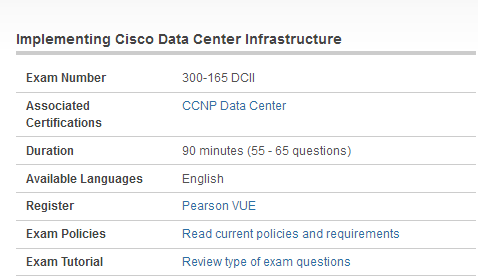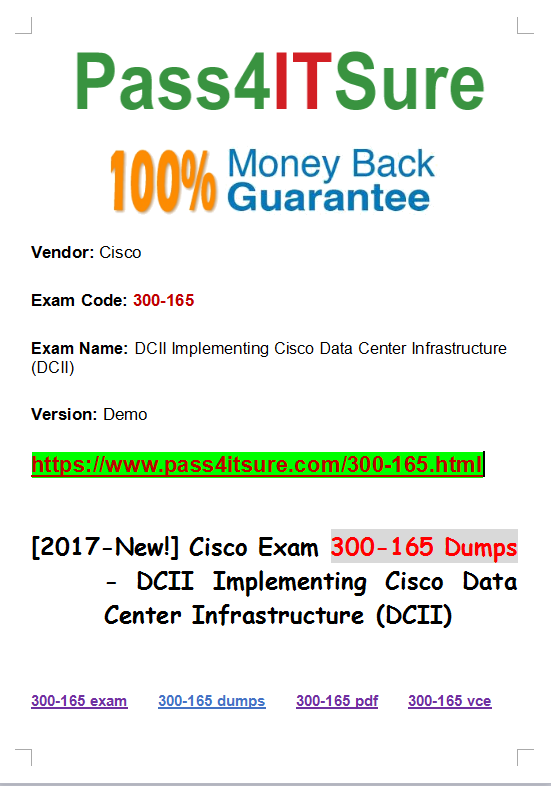[New Dumps] Up To Date Cisco CCNP 300-165 Dumps DCII Exam CCNP Data Center Certification Youtube Training Free Share Guaranteed Success
Which is the best way to prepare for Cisco 300-165 dumps? The Implementing Cisco Data Center Infrastructure (300-165 DCII) exam is a 90 minutes (55 – 65 questions) assessment in pass4itsure that is associated with the CCNP Data Center certification. Up to date Cisco CCNP 300-165 dumps DCII exam CCNP Data Center certification Youtube training free share guaranteed success.
“Implementing Cisco Data Center Infrastructure” is the exam name of Pass4itsure Cisco 300-165 dumps test which designed to help candidates prepare for and pass the Cisco 300-165 exam. Pass4itsure Cisco https://www.pass4itsure.com/300-165.html dumps exam is the most thorough, most accurate and latest practice test.
[New Other Cisco 300-165 Dumps From Google Drive]: https://drive.google.com/open?id=0BwxjZr-ZDwwWeTBEWVNsUmFmOEU
[New Other Cisco 300-170 Dumps From Google Drive]: https://drive.google.com/open?id=0BwxjZr-ZDwwWZzkydEcwa19TQWM

Pass4itsure Latest and Most Accurate Cisco 300-165 Dumps Exam Q&As:
1. In a Split MAC wireless network architecture, lightweight APs map user priorities (UPs) specified by the QoS STA on incoming frames to .
A. IEEE 802.1D Frame Precedence Values
B. GRE Priority Bits
C. IEEE 802.1Q Tag Protocol Identifiers D.
IP Differentiated Services Code Points E.
QoS Control Header Values
300-165 exam Answer: D
2. Given: An ingress frame arrives on the Ethernet port of an autonomous AP marked with an IEEE 802.1D user priority value.
Which IEEE 802.1D user priority values (by name) will assure the data payload carried by the Ethernet frame gets assigned to the highest priority WMM queue?
A. Controlled Load
B. Network Control
C. Video
D. Voice
E. Best Effort
F. Excellent Effort
Answer: BD
3. Given: When the delayed Block Ack policy is used between two QoS STAs, the recipient must respond to a BlockAckReq frame with an ACK frame. The recipient must then send its BlockAck
response frame in a subsequently obtained TXOP. Once the contents of the BlockAck frame have been prepared, the recipient must .
A. Send the BlockAck response frame to the originator in the earliest possible TXOP using the highest priority AC.
B. Send an ATIM to the originator signifying that the BlockAck response frame is ready for transmission.
C. Include the TID of the BlockAckReq in the next TXOP Request to the HC.
D. Wait for one PIFS after the next Beacon and transmit the BlockAck response to the originator using the same AC as the BlockAckReq frame.
300-165 dumps Answer: A
4. A QoS STA obtains a TXOP for an access category (AC) after what two parameters are met?
A. After a scheduled service period ends
B. The medium is idle at the AIFS[AC] slot boundary
C. The backoff time for that AC has expired
D. After a Block ACK Response
E. After a Target Beacon Transmission Time (TBTT)
Answer: BC
5. When using a protocol analyzer to capture conversations over a WLAN, you may often encounter encrypted data frames. Most WLAN protocol analyzers have a feature that allows the analyst to save and reload the captured frames into memory at a later time. Using this functionality, what task can be performed?
A. When IEEE 802.1X/LEAP is being used as the WLAN security mechanism, the authentication response frame can be replayed from a saved trace file at a later time to successfully authenticate a
hacker.
B. If a user name and password for an IEEE 802.1X/EAP-TTLS security implementation can be obtained through social engineering tactics, the user name and password can be entered into the analyzer to decrypt the frames from a saved trace file.
C. An analyst can search through the captured frames looking for RADIUS frames that will disclose the user’s password.
D. Encrypted frames may be decrypted offline, after they are captured, by entering a WEP key or WPA passphrase into the analyzer.
300-165 pdf Answer: D
6. How long, in microseconds, is the required Slot Time announced by an AP in an ERP BSS when both HR-DSSS and ERP-OFDM client stations are associated to the AP?
A. 2
B. 4
C. 9
D. 10
E. 20
Answer: E
7. The IEEE 802.11 standard allows for frame fragmentation. Which two fields in the IEEE 802.11 frame are involved in numbering data frame fragments and notifying the receiving station when all of the fragments of a data frame have been received?
A. Capability Information field
B. Frame Control field
C. ERP Information field D.
Sequence Control field E.
DS Parameter field
F. Ordered Service field
300-165 vce Answer: BD
8. According to the IEEE 802.11 standard (as amended), transmit power information is carried in which frames?
A. TPC Report frame
B. ADDTS Response frame
C. Probe Response frame
D. Beacon frame
E. Channel Switch Announcement frame
F. Measurement Report frame
Answer: ACD
9. What events will cause an established TSPEC to be deleted by a AP?
A. Disassociation of the non-AP QoS STA using the TSPEC from the QoS BSS
B. Traffic Stream inactivity timeout
C. Reassociation of the non-AP QoS STA with another QoS AP
D. Receipt of a DELBA frame from a non-AP QoS STA
E. Receipt of an Update TSPEC frame from a non-AP QoS STA
F. A Controlled Access Phase (CAP) burst
300-165 exam Answer: ABC
10. Many autonomous access points support IEEE 802.1Q VLAN tagging. When analyzing a WLAN system using IEEE 802.1Q tags, where can the VLAN tag number be seen?
A. In the Sequence Control field of the MSDU
B. In the PLCP header’s Service field
C. In the Frame Control field of the MPDU header
D. In the Ethernet header on the wired port of the access point
E. In the Beacon Management frame’s Capabilities fixed field
Answer: D
11. Given: ABC Company is implementing a QoS enabled infrastructure that will support both voice and data. The WLAN controller is connected to one of three core layer-3 Ethernet switches. Each core layer-3 Ethernet switch has multiple edge layer-2 Ethernet switches attached. Lightweight APs are connected to all edge layer-2 Ethernet switches. The WLAN controller is on subnet 10.1.1.0/24, and the APs are on numerous other subnets. The APs are connected to the WLAN controller via LWAPP tunnels. When IEEE 802.11 frames arrive at a lightweight AP from a QoS STA that need to be sent to the WLAN controller, which bits can the AP mark to signal the layer-2 and layer-3 Ethernet switches to use higher priority processing?
A. The Ethernet frame’s 802.1Q priority tag bits
B. The IP header’s TOS bits
C. The IEEE 802.11 frame’s QoS Control bits
D. The LWAPP header’s C bit
E. The UDP header’s PRI bits
300-165 dumps Answer: AB
12. Given: ABC Company has implemented a QoS capable IEEE 802.11 WLAN controller based network with lightweight access points as shown in the graphic. What is the advantage of the access point mapping IEEE 802.11 user priority (UP) values to DSCP values in the IP header that encapsulates the 802.11 frame?
A. Direct mapping of UP-to-DSCP values increases effective throughput between the access point and WLAN controller.
B. Since UP-to-802.1Q PCP mappings are not possible at the access point, the only method of prioritizing upstream data is through UP-to-DSCP mappings.
C. The QoS markings will survive layer 2 hops that could remove 802.1Q PCP values.
D. UP-to-DSCP mappings are more granular than UP-to-802.1Q PCP mappings.
Answer: C
13. What does a TXOP Limit value of 0 in the EDCA Parameter Set included in a QoS AP’s Beacons or
Probe Response frames indicate?
A. It indicates that one or more MSDUs or MMPDUs must be transmitted at the lowest basic rate during each TXOP.
B. It indicates that QoS STAs must wait for the HC to transmit a Polled TXOP before they can transmit MSDUs or MMPDUs.
C. It indicates that no MSDUs or MMPDUs may be transmitted by a non-pollable QoS STA. D.
It indicates that a single MSDU or MMPDU may be transmitted at any rate for each TXOP.
E. It indicates that QoS STAs may transmit voice MPDUs (Access Category 7, 8) during TXOPs.
300-165 pdf Answer: D
14. What is indicated to a QoS AP when a QoS STA sets U-APSD Flag bits to 1 in Association and Reassociation frames?
A. Which access categories are both trigger- and delivery-enabled.
B. The maximum number of data frames that should be queued by the QoS AP for that QoS STA.
C. The number of TXOPs that are requested by this QoS STA.
D. Which user priorities are mapped to access categories.
E. Which access categories are scheduled.
Answer: A
15. ABC Corp has just installed a single HR-DSSS access point into their medium-sized office environment. As the WLAN administrator at ABC Corp, you use a wireless protocol analyzer to troubleshoot a performance problem. You place your analyzer close to the access point, and capture some traffic from office users. Given the screenshot shown, which statement offers the best explanation for the poor WLAN performance of ABC’s new HR-DSSS WLAN?
A. There is likely a source of RF interference somewhere around the access point. This is causing many data frames to be retransmitted, so overall WLAN throughput has been greatly diminished.
B. Due to an ERP client joining the BSS, protection mechanisms have been enabled in the BSS by the access point. These protection mechanisms greatly increase protocol overhead, thereby decreasing overall WLAN throughput.
C. A nearby HR-DSSS access point is operating on an adjacent channel causing a significant amount of corrupt frames within ABC’s BSS. These corrupt frame fragments are congesting the channel on which
ABC’s WLAN is operating, thereby decreasing its throughput.
D. One of the WLAN users has moved far enough away from the access point that his client station has begun transmitting frames at the minimum supported data rate. Even when a single user uses this rate for Data frames, throughput for the entire WLAN as a whole is slowed significantly.
300-165 vce Answer: D
16. Which statements accurately describe IEEE 802.11 EDCA collision handling in a WMM compliant infrastructure WLAN?
A. Data frames from lower priority colliding ACs behave as if there were an external collision on the wireless medium.
B. Collisions between contending EDCAFs within a QoS STA are resolved within the QoS STA
C. WMM-compliant applications collaborate within a QoS STA to handle transmission collisions at layer 7 of the OSI model
D. The WMM specification requires use of RTS/CTS as part of the EDCAF in each QoS STA to avoid internal collisions between applications
E. Collisions within a QoS STA do not require setting retry bits in MAC headers of MPDUs from lower priority ACs
Answer: ABE

You will find that it is the only materials which can make you have confidence to overcome difficulties in the first. Cisco 300-165 dumps exam certification are recognized in any country in the world and all countries will be treate it equally. Cisco https://www.pass4itsure.com/300-165.html certification not only helps to improve your knowledge and skills, but also helps your career have more possibility.
